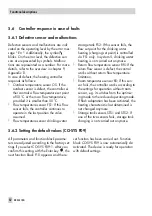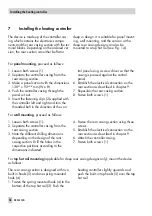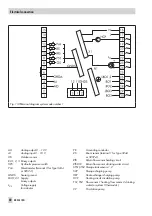
Optimizing mode 2 (only with CO1 F01-1, i.e. with room sensor)
The activation point of time of the heating sys-
tem depends on the outdoor temperature.
Exactly as for optimizing mode 1, you are
required to adjust the maximum permissible
Preheating time (function block parameter).
The deactivation point of time of the heating
system is selected by the heating controller so
that the temperature does not significantly
drop below the Room set point (PA1) prior
to the end of rated operation. Solar radiation
may increase the room temperature, thus
causing the heating system to be deactivated
prematurely. The deactivation point of time
can be as early as 2 hours before the
adjusted time-of-use. During the time of
non-use, the heating system is deactivated at
first. The Reduced room set point (PA1) is
monitored. If the temperature falls below this
value, the flow temperature is controlled for
reduced operation.
Optimizing mode 3 (only with CO1 F01-1, i.e. with room sensor)
Activation/deactivation of the heating system
depends on the room sensor. The heating
controller determines the required preheating
time automatically, so that the room set point
(PA1) is reached at the start of the
time-of-use in the reference room. The pre-
heating time varies, depending on the time of
the year and the climatic conditions, taking
up to 6 hours. This is the case, for example,
when the Optimize function is used for the
first time and the heating controller has not
yet stored any information about the building
characteristic. The heating system is deacti-
vated in such a way that the temperature
does not drop below the Room set point
(PA1) until the end of the time-of-use, i.e.
maximum 2 hours before, however, not later
than the end of the time-of-use. During the
time of non-use, the room temperature is
monitored. If midnight lies within this time
period, the Sustained temperature (PA1) is
monitored. If midnight is not within this
period, the Reduced room set point (PA1) is
monitored. As long as the temperature does
not fall below these limit values, the maxi-
mum flow set point is used for heating.
5.4.6 Flash adaptation (CO1 F03, only with room sensor)
The Flash adaptation function CO1 F03-1 is
used to compensate for room temperature vari-
ations by up to
±
30 °C during the time-of-use
by means of parallel displacement of the heat-
ing characteristic. During this process, the heat-
ing controller compares the room temperature
to the Room set point (PA1) in fixed intervals.
The intervals are determined with the function
block parameter Cycle time (default 10 min).
As soon as the room temperature deviates by
more than 0.5 K from the set point, the charac-
teristic is displaced by
±
1 K each time. The dis-
placement is reset during the time of non-use.
With the remote control (option for Type 5244
or 5257-4), you can additionally change the
room set point by
±
5 K.
NOTE:
Cooling loads, such as drafts or open
windows influence the control! Rooms may be
briefly overheated once the cooling load is
eliminated.
46
EB 5431 EN
Functional descriptions
Summary of Contents for TROVIS 5431
Page 96: ......
Page 97: ...Code number EB 5431 EN 97 Code number 1732...
Page 98: ......
Page 101: ......






























